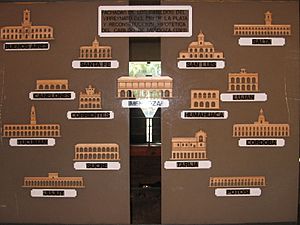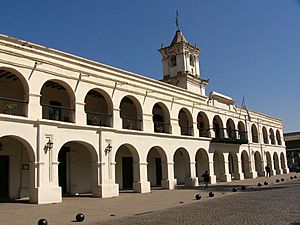Cabildo (council) facts for kids


A cabildo (pronounced ka-BIL-doh) or ayuntamiento (pronounced ah-yoon-tah-MYEN-toh) was a special council in the Spanish colonies. It was like a city government that managed a town or city and the lands around it. These councils were important during the time Spain ruled many parts of the Americas and the Philippines.
Sometimes, members of the cabildo were chosen by others, and sometimes they were elected. But they always represented the people who owned land in the area. The idea for the cabildo came from similar city councils that existed in Spain during the Middle Ages.
The cabildo was the official voice for the city and its people to the Spanish king. This is why it was one of the first things the Spanish conquistadors set up when they took over a new area. For example, Hernán Cortés created a cabildo in La Villa Rica de la Vera Cruz to gain independence from the governor of Cuba.
The word cabildo comes from the same Latin word as the English word "chapter." In Spanish, cabildo can also mean a group of priests who manage a cathedral. The term ayuntamiento was often called excelentísimo (meaning "most excellent") to show respect for the council.
Contents
What Was the Cabildo?
The cabildo was the local government in Spanish colonial cities. It was in charge of many things, like making local laws and managing the city's money. It also helped keep order and solve problems for the people living there.
In theory, every town and city in the Spanish colonies had a cabildo. These "municipalities" included not just the city itself but also all the surrounding countryside. The cabildo usually reported to a higher official called the presidente of the audiencia (a type of high court). The presidente then reported to the viceroy, who was the king's main representative.
The cabildo had three main jobs:
- Judicial: They acted like judges, solving legal cases.
- Legislative: They made local laws and rules.
- Administrative: They managed the day-to-day running of the city.
Because of these roles, the cabildo was often called Consejo, Justicia y Regimiento (Council, Justice, and Government).
Who Was in the Cabildo?
A cabildo had several different types of officials:
- Regidores: These were like council members. There were usually four to twelve regidores, depending on how big and important the city was. They didn't just discuss things; they also helped manage the city's territory. At first, all land-owning men could vote for regidores. But over time, kings started appointing some or all of them to keep control.
- Alcaldes: These were like magistrates or judges. There were usually one or two alcaldes, and the regidores elected them every January 1st. Alcaldes were the first judges for criminal and civil cases. They also led the cabildo meetings unless a corregidor was present.
- Corregidores: The king appointed these officials to represent him directly and oversee the cabildos. They made sure the city councils followed the king's rules.
Other important officers included:
- Alférez real: The royal standard-bearer, who could vote in meetings.
- Alguacil mayor: The chief law enforcement officer, like a police chief.
- Fiel ejecutor: This person checked weights and measures in markets, made sure the city had enough supplies, and oversaw public cleanliness.
- Procurador: The city attorney, who represented the city's interests.
- Scribe: A person who wrote down all the official records and decisions.
Over time, the Spanish kings made changes that led to more officials from Spain (called peninsulares) being appointed to high positions. This meant that creoles (people of Spanish descent born in the Americas) had fewer chances to get these jobs. Because of this, creoles became more involved in the cabildos, making them a center of power for them. This shift played a big role in the events leading up to the Spanish American wars of independence. After these wars, many new nations kept the cabildo system for a while, but eventually, they replaced them with modern city councils.
Where Are Cabildos Today?
The word "cabildo" was also used for the building where the city government met. You can still find buildings named "Cabildo" in parts of Latin America, and even in New Orleans, USA.
Today, cabildos only exist in the Canary Islands (off the coast of Africa, belonging to Spain). Each island has its own cabildo insular, and their members are elected by the people. These island cabildos are similar to the island councils found in the Balearic Islands of Spain.
Images for kids
See also
 In Spanish: Cabildo colonial para niños
In Spanish: Cabildo colonial para niños
- Ayuntamiento
- Corregidor
- Municipal council
- The Cabildo
- Crown of Castile
- Open cabildo
- Alcalde
- Alcalde ordinario
- Sargento mayor
- Regidor
- Síndico
- Corregimiento
- Teniente a guerra
- Santa Hermandad





